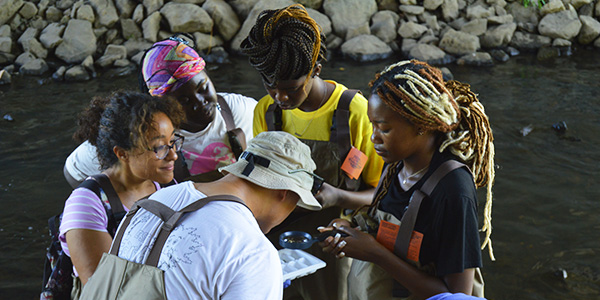It wasn’t like Marissa Glaze had never experienced pollution before. She’d seen trash littering the sidewalks of her new neighborhood when she first moved to Mount Vernon, NY, just as she’d seen it back in Jamaica, where she lived for the first dozen or so years of her life. She couldn’t ignore discarded cans and plastic bottles wherever she walked, so many that she decided to collect all she could, stash them in garbage bags, then schlep the full bags to the supermarket and exchange her haul of recyclables for the standard deposit bounty of five cents apiece.
But she had never had encountered trash pollution in the water before. Not until it brushed up against her when she was standing in the shallows of Long Island Sound at Orchard Beach in the Bronx. The shock of feeling that plastic bag on the skin of her leg changed everything.
“I’ve never really seen pollution in water until I came to America,” said Marissa, a recent graduate from the Denzel Washington School of the Arts. “I grew up on this beautiful island with beautiful water. There was pollution, but it was never in the water. Coming up here and seeing it in the water, it sparked something within me.”
That crossroads moment eventually led Marissa into a stretch of the Hutchinson River on a hot summer Sunday. Geared up in loaner waders and armed with data collection forms in waterproof cases, Marissa and five other high school and college students from the Boys & Girls Club of Mount Vernon spent a couple of hours walking two 5-meter transects, kicking over rocks on the streambed, and collecting whichever critters lived under them in fine-mesh nets. At the end, they gathered in the shallow water beneath the East Third Street overpass, sorted the macroinvertebrates they’d caught in cells of an ice cube tray, looked through magnifying glasses to identify them, and logged what they had found.
The outing was part of New York State’s 10-year-old WAVE program (Water Assessments by Volunteer Evaluators), and was the culmination of preparations that began with a crash course in macroinvertebrates, river ecology, water pollution, and sampling techniques, led by Save the Sound clean water advocate Sam Marquand. The team met several times in our new John and Daria Barry Foundation Water Quality Lab in Larchmont, and once in Mount Vernon.
“It’s fun and exciting to work with young people who are just coming into the realization that this is something that they love, something that’s important to them,” said Sam, who guided the crew of young community scientists along with other local volunteers. “To be there as that it happening for them is really cool.”
“Marissa was the impetus for me to try to look into programs that would satisfy her curiosity and help expose her to more things,” said Sandy Narain, the teen coordinator at the Boys & Girls Club. “And if she was interested, there would be more kids like her who perhaps would like to explore environmental issues.”

Marissa may have been the catalyst, but she was not the only student who enjoyed their slow hike up the Hutch. Together, they uncovered an assortment of creatures, from leeches to red midge and mosquito larvae, some freshwater clams, and even isopods they couldn’t initially identify but turned out to be sowbugs.
“We saw a lot of leeches and worms,” said Yakira Vanterpool, a rising senior at Denzel Washington. “It was cool, but it was bad for the water, I think, because we mostly found the bad things.”
Technically, what the students found were not “bad.” They were just the hardiest animals that thrive in “bad” conditions. WAVE has three categories of organisms to help determine the water quality of a sampled area: Most Wanted, Least Wanted, and Other. All four organism types identified by the students were on the DEC’s Least Wanted List.
“As we found no ‘Most Wanted’ species and only ‘Least Wanted,’ that means the section of the Hutchinson River in which we were sampling is likely impaired and may deserve further investigation by the Department of Environmental Conservation,” said Sam, who packaged up the data along with one sample of each organism and shipped it all to WAVE.
That, actually, is a good thing. Once a body of water is identified as potentially impaired, something can be done to address whatever is causing its problem. According to the WAVE website, DEC has “been able to respond to every site that was flagged as possibly impaired.”
Such is the impact of community science programs like this. When the new WAVE map is released, there will be a dot on it – probably a yellow one – marking the section of the Hutchinson River traveled and investigated by the Boys & Girls Club students. It will be the first data point plotted on the Hutch and in Mount Vernon, and it could represent a first step in the direction of healing a river badly compromised by pollution likely resulting from sewage leaks and polluted stormwater runoff.
And this work will continue. Sam will run another sampling session with the Boys & Girls Club of Mount Vernon in the coming year, and he hopes to bring the program to other watersheds in New York that have yet to be added to the WAVE map.
“I feel like it takes a group of people, like a group of us coming here to test the water, to make a change,” said Marissa. “You’re not going to see the change right now. Probably not in a year or five years, but you are going to make a change.”
